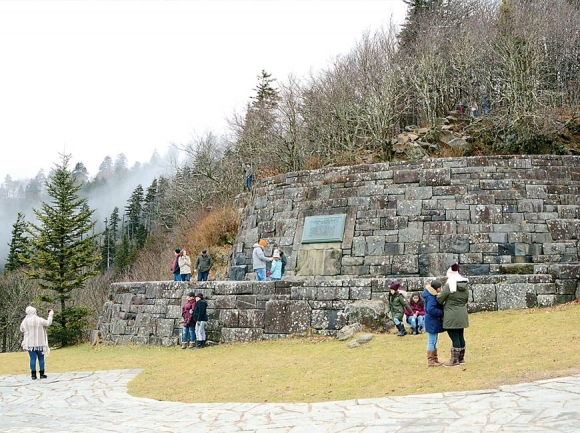Back to work: Shutdown ends, but effects likely to linger through 2019 season
 Despite the shutdown, visitors congregate Jan. 7 at Newfound Gap. Holly Kays photo
Despite the shutdown, visitors congregate Jan. 7 at Newfound Gap. Holly Kays photo
After 35 days of furlough, National Park Service staff are back to work at the Great Smoky Mountains National Park, the Blue Ridge Parkway and more than 400 other National Park Service units nationwide.
“On behalf of the employees of Great Smoky Mountains National Park, I want to express our heartfelt gratitude to our partners and communities for their unwavering support over the last five weeks,” said Smokies Superintendent Cassius Cash in a press release. “In addition to the monetary support offered by our partners to provide basic visitor services, we were moved by the number of people and organizations who stepped up to organize litter pickups and the outpouring of generosity expressed to our employees through meals and gift cards.”
During the shutdown, only a select few “essential” employees — a bare-bones crew of law enforcement officers, mainly — were working in the 816-square-mile park. No government funds were available to operate visitor centers or bathrooms — with the exception of some recreation fee funding released later in the shutdown, money that would have otherwise gone toward the Smokies’ $215 million deferred maintenance backlog — and administrators who would normally be preparing contracts for summer roadwork, hiring seasonal employees, and collaborating with park partners to apply for grants and plan programs were out of commission.
All employees — essential and nonessential — went without pay, missing two paychecks over the course of the shutdown. With the government now reopen, they will soon receive backpay for those missed pay periods as if they had been working a normal schedule.
Support from park partners
Thanks to support from organizations like the Great Smoky Mountains Association, Friends of the Smokies and the Blue Ridge Parkway Foundation, some limited visitor services were offered during the busiest periods of the past month, and enthusiastic support from parkside communities helped reduce roadside litter buildup.
Related Items
“We’re here for our park,” said Anna Zanetti, North Carolina director for Friends of the Smokies. “We love the Smokies.”
Just under 24 hours before President Donald Trump signed a bill ending the shutdown around 9 p.m. Friday, Jan. 25, Friends of the Smokies released a plan to fund visitor center operations through Feb. 18, should the shutdown continue that long. The organization, which previously gave $18,000 to maintain bathrooms at Newfound Gap and Cades Cove when human waste was found in those areas, pledged $33,000 to keep the visitor centers and associated restrooms at Sugarlands and Oconaluftee open on weekends through President’s Day.
The Blue Ridge Parkway Foundation made a similar pledge, Friday morning announcing that it would spend around $7,000 to open the visitor center in Asheville on weekends through Feb. 10.
Both organizations said that they would offer similar support even further into the future, should the shutdown linger past mid-February.
“I didn’t want to make a plan for a shutdown longer than that, because that just seemed sad,” Carolyn Ward, CEO of the Blue Ridge Parkway Foundation, said the morning of Jan. 25. “But if the shutdown does continue and we can receive support from folks in the community, we would plan to continue it. It’s too important and too critical.”
It’s possible that plan could still be called into action, as the spending bill that allowed the government to reopen is good only through Feb. 15. President Donald Trump has made it clear that he would allow the shutdown to resume if the border wall isn’t funded at that time.
“This was in no way a concession,” he posted on Twitter Jan. 25. “It was taking care of millions of people who were getting badly hurt by the Shutdown with the understanding that in 21 days, if no deal is done, it’s off to the races!”
Returning to a backlog
The Smokies and the Parkway fared better than many other national park units left unattended during the shutdown. Due to winter weather in the weeks leading up to the shutdown, the Parkway was closed along most of its length in Western North Carolina save the Asheville commuter section. While the Smokies continued to receive a steady stream of visitors over the past month, January is typically one of its lowest-visitation months. Because the park had a pre-existing trash removal contract in place with a private company, overflowing trashcans were not a problem. That, coupled with volunteer cleanup efforts and funding from park partners and recreation fees to keep some restrooms open, kept the park largely clear of any massive waste issues.
But that doesn’t mean that the shutdown’s end is simply a return to business as usual. There are myriad tasks that park staff should have been working on for the past five weeks that are now on backlog.

A family enjoys a hike on Alum Cave Trail during the partial government shutdown. Holly Kays photo
“They cannot instantaneously complete all the work they would have done in the last 34 days,” said Laurel Rematore, executive director for the Great Smoky Mountains Association, on Jan. 24. “We are definitely going to be seeing impacts to visitor services this summer. I am predicting the Park Service will have difficulty hiring enough interns and seasonals to provide the entire array of visitor services that are normally available.”
The Smokies has about 190 year-round employees and the Parkway about 150 — but seasonals, who typically come to work between March and May and leave after the fall season, are essential to providing lengthened visitor center hours, increased educational programming and visitor information in the busy summer and fall months. The Smokies hires about 80 seasonal employees and the Parkway 125.
In a typical year, hiring would have already been well underway, with some positions already filled and others advertised on USAjobs.com. The shutdown has stalled that process, and Rematore expects that the other governmental offices that support Park Service hiring processes — such as the Office of Management and Budget and the Human Resources Operational Services — will be so far behind due to the shutdown-induced backlog that they’ll struggle to meet the need fast enough.
“They’re going to be absolutely inundated because all of the parks are going to be trying to get their people hired instantly,” said Rematore. “It’s going to be very interesting here once the park reopens and once it’s fully staffed. That’s not interesting in a good way.”
The high-elevation portions of the Blue Ridge Parkway in Western North Carolina are often closed much of the winter, as the road is subject to ice and snow that’s absent from the lower elevations. But a parade of winter weather and wind events over the past month will likely increase that challenge as newly returned Parkway employees work to assess conditions and clear obstacles along the length of the 469-mile road.
“Employees along the entire Blue Ridge Parkway are glad to be back at work,” said Superintendent J.D. Lee. “We are so grateful to the committed Parkway staff, partners and neighbors that supported the Parkway during the lapse in appropriations. We had several weather events before and during the lapse that will continue to impact Parkway travel in the coming days and weeks. We appreciate the public’s patience and cooperation as we prioritize work to provide access to this special resource.”
Impacts to park partners
Rematore’s organization has a particular interest in any development that could restrict operating hours for park visitor centers. GSMA operates bookstores within each of the park’s visitor centers, with proceeds from those sales supporting park needs — GSMA’s budget, therefore, is largely dependent on visitor center hours. During the shutdown, the organization lost about $26,000 in store sales, the profits of which would have been invested right back into the park.
However, due to lessons learned from the 16-day shutdown in 2013, GSMA established a reserve fund that allowed it to protect its planned $1.3 million in 2019 donations to the park and to continue to pay its bookstore staffers who were unable to work during the shutdown. But, those reserves have a limit. If the shutdown were to resume in February, there’s no guarantee the organization could continue to maintain its current staff and funding plans.
“Downstream we’ll have to make adjustments,” Rematore said. “We may not have the same number of staff members this time next year, or we may not be making a cash contribution commitment to the park next year that’s the same as this year, because if we don’t have the money we can’t give it to them.”
Friends of the Smokies is also expecting January’s shutdown to yield yearlong effects.
Earlier this month, Zanetti said, she had to withdraw Friends’ application for a $30,000 grant from the Cherokee Preservation Foundation that would have leveraged various other funds to yield $108,000 for the Seeking Paths in Nature Program, which teaches Cherokee children about the connections between Cherokee culture, history, the environment, plants and animals in the Smokies. The application was on track for approval, but the Preservation Foundation needed a few clarifying questions answered that required Park Service input to complete. The organization granted a three-week deadline extension, but even that wasn’t enough to outlast the shutdown.
“That really hurt because we spent so much time and energy on that, so that was unfortunate we had to do it. But we’re still in good standing with the Cherokee Preservation Foundation,” said Zanetti, adding that the Foundation has been “very cooperative” and “very understanding” of the situation.
Friends of the Smokies has pledged $2.7 million in support for the park in 2019, with projects ranging from radio system updates to road improvements to exhibit installations. Friends raises the money to fund these programs, and the park executes them — but Zanetti worries that the delay in hiring and backlog of maintenance tasks caused by the shutdown could mean that the Park Service won’t be able to execute all the projects Friends is offering to fund.
“Park staff might not be able to fulfill all the things we said we would provide money for due to the shutdown,” she said Jan. 25. “When they get back to work, whenever that may be, they’re going to have a huge backlog of maintenance that hasn’t been attended to, just general work they have not been able to do, hiring seasonals which starts taking place now, and the park’s heavily dependent on seasonal workers. There’s just going to be a really big ripple effect.”
How big that ripple effect will be hinges on what happens when the current funding bill expires Feb. 15. A more stable funding plan is needed before things can truly return to normal, said Ward.
This short-term stop-and-go approach, she said, results in “this constant sort of terror of whether or not you can come to work and whether or not you’re actually going to get a paycheck. It’s devastating, not to mention the impacts to our park.”









